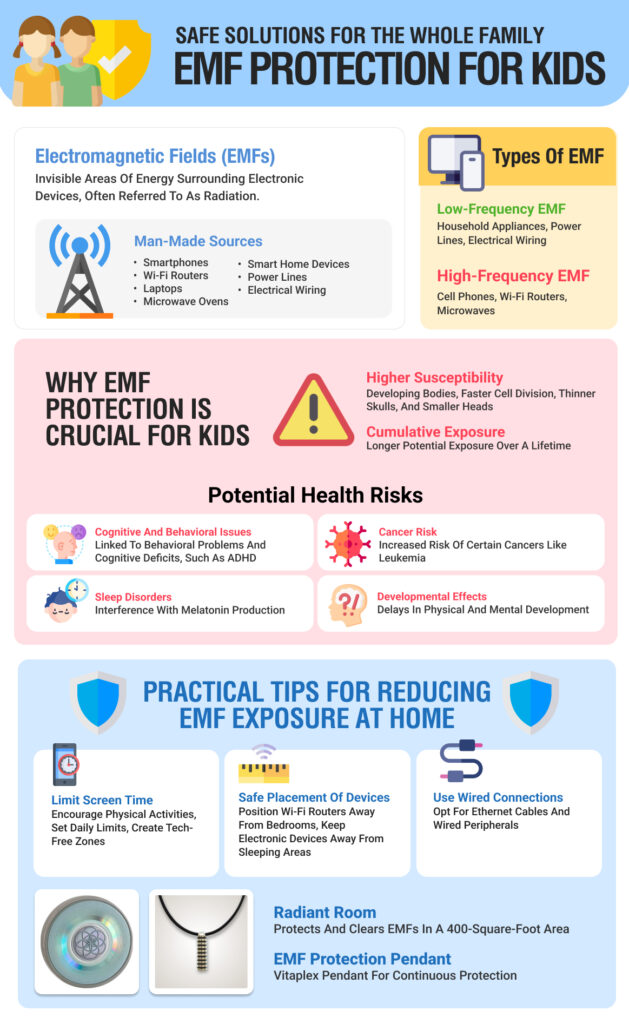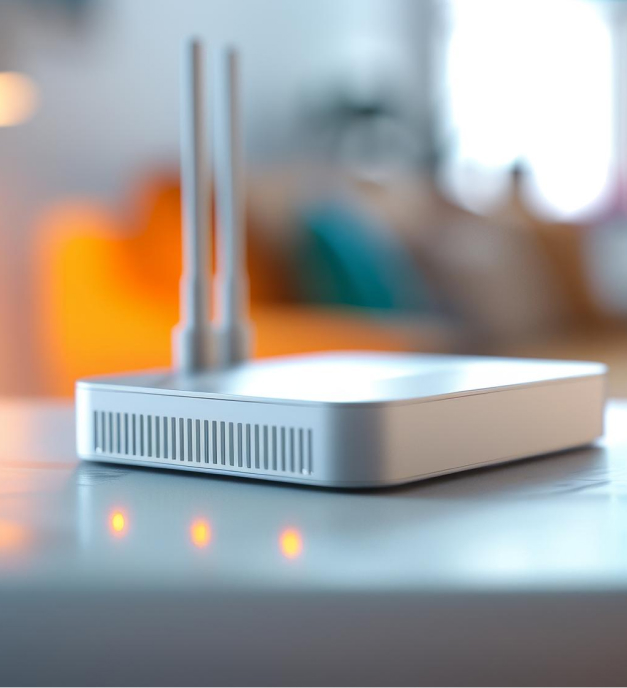EMF Protection for Kids:
Safe Solutions for the Whole Family

EMFs and Its Sources
Electromagnetic fields (EMFs) are invisible areas of energy that surround electronic devices. They are often referred to as radiation and are associated with the use of electrical power and various forms of natural and man-made lighting.
EMFs are produced by everything from the sun to the smartphones we carry in our pockets. They are non-ionizing electromagnetic radiation, meaning they do not carry enough energy to ionize atoms or molecules or remove tightly bound electrons.
Common Sources of EMF in Homes and Schools
EMFs are ubiquitous in modern life, emanating from numerous sources in both homes and schools. Understanding these sources can help in managing and reducing exposure, particularly for children. Here are some of the most common sources:
- Wi-Fi Routers: These devices emit EMFs continuously as they provide wireless internet connectivity throughout homes and classrooms.
- Cell Phone and Mobile Devices: Portable devices are significant sources of EMF due to their frequent use and proximity to the body.
- Laptops and Computers: These essential tools for work and study also generate EMFs, especially when connected to Wi-Fi.
- Microwave Ovens: While in use, these appliances emit high levels of EMF within the kitchen.
- Smart Home Devices: Gadgets like smart thermostats, speakers, and baby monitors contribute to a home's overall EMF environment.
- Power Lines and Electrical Wiring: Overhead power lines and the internal wiring within buildings generate EMFs, particularly high-voltage lines.
Types of EMF (Low-Frequency, High-Frequency)
EMFs are categorized based on their frequency, which influences their energy levels and potential impact on health.
- Low-Frequency EMF: These EMFs have a lower frequency and longer wavelength. Common sources include household appliances, power lines, and electrical wiring. Low-frequency EMFs are typically considered less harmful than their high-frequency counterparts but can pose health risks with prolonged exposure.
- High-Frequency EMF: These EMFs have a higher frequency and shorter wavelength. They are emitted by devices such as cell phones, Wi-Fi routers, and microwaves. High-frequency EMFs are more energetic and can penetrate the body deeply, leading to more significant concern over potential health effects, particularly chronic exposure.

Why EMF Protection is Crucial for Kids
Children are more susceptible to the effects of EMF exposure due to their developing bodies. Their cells are dividing at a faster rate than adults.
Additionally, children have thinner skulls and smaller heads, which allow EMFs to penetrate more deeply into their brains. This deep penetration can lead to more significant effects.
The cumulative exposure over a lifetime means that starting from a young age can result in prolonged exposure, increasing potential risks.
Potential Health Risks
Several health risks are associated with prolonged EMF exposure, although research is ongoing, and not all findings are conclusive. Cognitive and behavioral issues are of particular concern. Some studies suggest that high levels of EMF exposure may be linked to behavioral problems and cognitive deficits in children, such as attention deficit hyperactivity disorder (ADHD).
Exposure to EMFs, especially at night, can also interfere with the production of melatonin, a hormone that regulates sleep, leading to sleep disorders.
There are also concerns about long-term exposure to EMFs and an increased risk of certain types of cancer, such as leukemia. Although the evidence is not definitive.
EMF exposure has been suggested to potentially affect the development of the nervous system, leading to delays in physical and mental development. Some children may experience symptoms such as headaches, fatigue, and dizziness, which are sometimes attributed to EMF exposure.
Current Research and Studies on EMF and Children's Health
Research into the effects of EMF exposure on children's health is an active field, with new studies emerging regularly. The International Agency for Research on Cancer (IARC), a part of the World Health Organization (WHO), has classified radiofrequency electromagnetic fields as possibly carcinogenic to humans based on an increased risk for glioma, a malignant type of brain cancer associated with wireless phone use. The BioInitiative Report, a comprehensive review of EMF research, highlights numerous studies that suggest a link between EMF exposure and various health effects, emphasizing the need for precautionary measures, especially for children.
Practical Tips for Reducing EMF Exposure at Home
Follow these tips to keep the EMF exposure surrounding your children to a minimum:
Limiting Screen Time
One of the most effective ways to reduce EMF exposure is by limiting screen time. Encourage children to engage in more physical activities, such as playing outside, reading books, or participating in sports and hobbies that do not involve electronic devices. Setting daily limits on screen time can help reduce the overall exposure to EMFs.
Additionally, create tech-free zones and times in your home, such as during meals or family game nights, to promote face-to-face interactions and physical activities.
Safe Placement of Wi-Fi Routers and Electronic Devices
The placement of Wi-Fi routers and other electronic devices can significantly impact the levels of EMF exposure in your home. Position Wi-Fi routers in central but low-traffic areas, away from bedrooms and common living spaces where family members spend a lot of time. Avoid placing routers on desks or near seating areas where children do their homework or play.
Similarly, electronic devices like cordless phones, tablets, laptops, and smartphones should be kept away from sleeping areas. Turn off these devices or switch them to airplane mode to reduce unnecessary exposure when not in use.
Using Wired Connections Instead of Wireless When Possible
Whenever possible, you should opt for wired connections instead of wireless ones. For instance, use Ethernet cables to connect computers and other devices to the internet. This can significantly reduce EMF exposure from Wi-Fi signals. Consider using wired keyboards, mice, and headphones instead of their wireless counterparts. While wired connections may seem less convenient, they provide a safer alternative by minimizing the constant emission of EMFs.

EMF Protection Devices and Products for Kids
There are growing concerns about EMF exposure, and because of that, unique and handy products have been developed for your safety.
- EMF-Blocking Phone Cases: These cases are designed to reduce the amount of EMF radiation emitted from smartphones. They often contain materials that can block or absorb EMF waves, thus minimizing exposure when the phone is in use.
- EMF Protection Pendant: The Vitaplex Pendant is permanently encoded to clear, protect, and energize, supporting you and keeping you safe from harmful EMFs.
- Radiant Room: This product protects your house and clears up 400 square feet. You and your children can feel safe from EMFs inside your own home.
- EMF Protection Clothing: Clothing items like hats and shirts are embedded with EMF-resistant materials to provide continuous protection throughout the day.
Creating a Safer Future for Our Children
Protecting children from EMF exposure can be beneficial for their long-term health and development. Implementing these practical tips and using effective EMF protection products can significantly reduce your family's exposure to potentially harmful electromagnetic fields.
Staying informed and proactive will help create a safer, healthier environment where your children can thrive.
Know Your EMF Health Risks
- Cell and Smart Phones
- Electrostress from Computers
- EMFs in the Home
- Electrostress and Travel
- Is Wi-Fi Dangerous? Here’s What You Need to Know
- How to Protect Yourself in the Age of 5G Side Effects
- Power Lines
- Cell Towers
- Radiation from the Earth
- EMFs from Underground Pipes
- Smart Meters
- 5G Dangers & Health Effects: What You Need to Know




